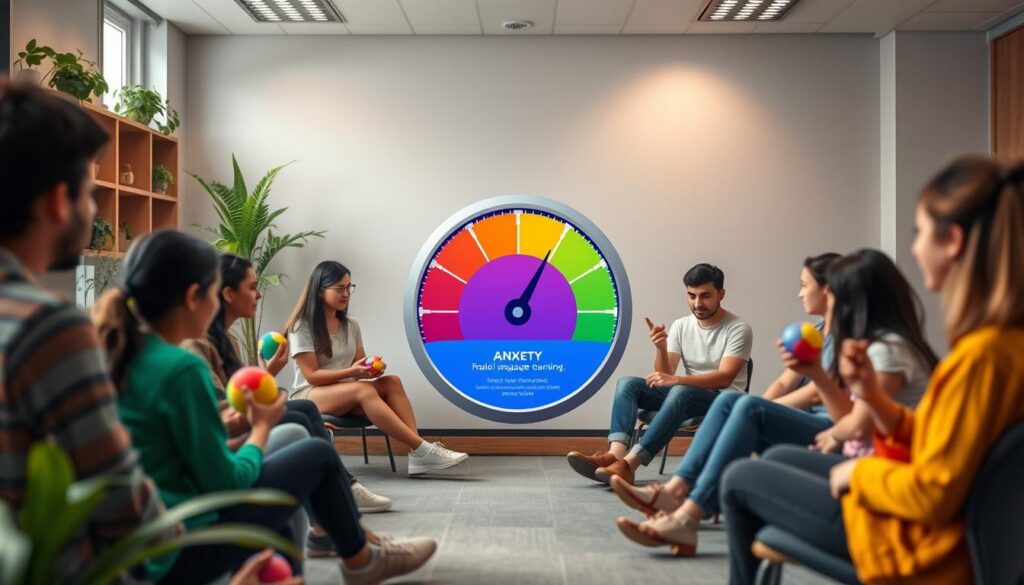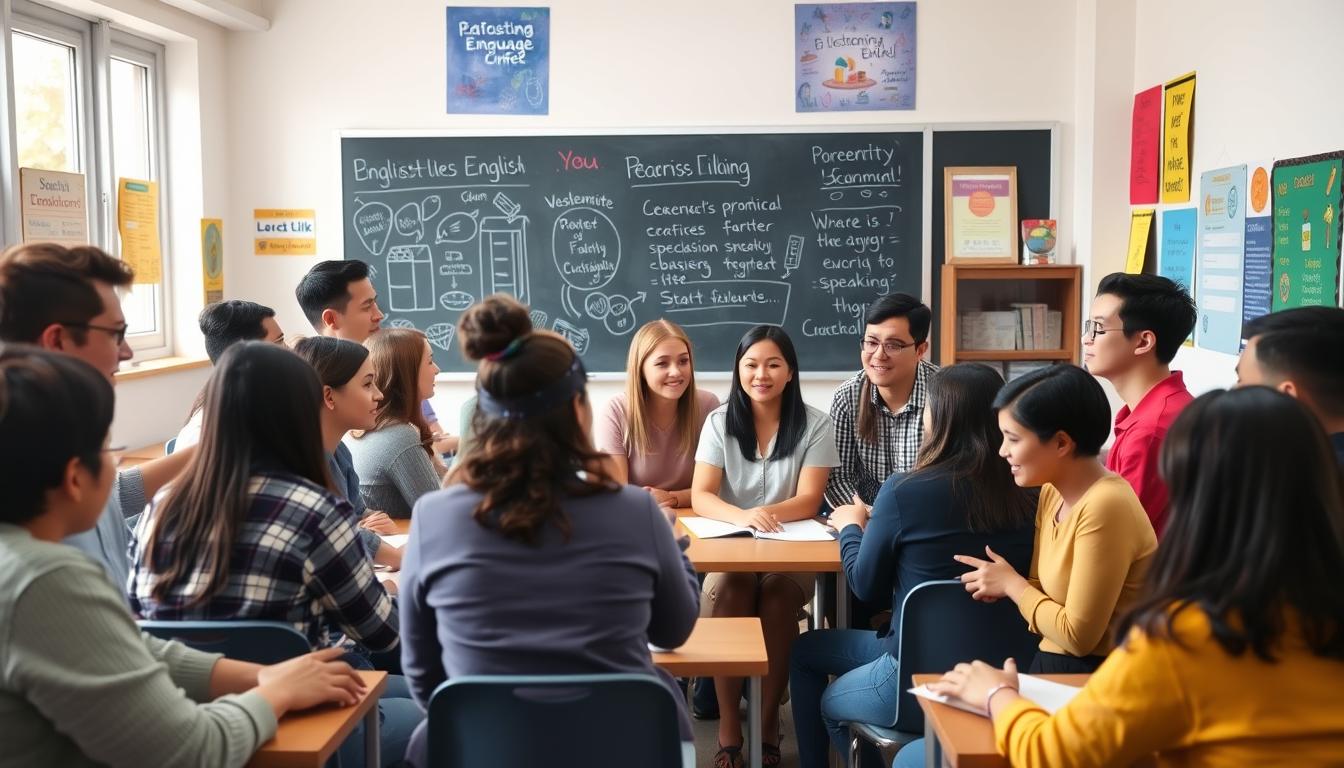Imagine a classroom full of students eager to learn English. They all look forward to the teacher’s next move. The teacher has a plan to make them feel more confident and fluent in English.
We will look at many english speaking activities in this article. These include conversation practice, pronunciation drills, role-playing exercises, and vocabulary building games. These activities help students feel more at ease when speaking English.

Key Takeaways
- Discover a range of engaging English speaking activities to boost confidence and fluency
- Learn strategies for creating a supportive, low-anxiety learning environment
- Explore techniques for incorporating authentic materials and real-life scenarios
- Understand the importance of providing positive feedback and encouraging student progress
- Discover how to leverage group work and peer learning to enhance speaking skills
Importance of Speaking Confidence for English Learners
Many English language learners struggle with anxiety, making it hard to speak up in class. They worry about making mistakes or being laughed at. For ESL students, learning English is tough because they often come from low-income backgrounds.
Language-learning anxiety as a barrier to oral communication
Research shows that anxiety can really hurt ESL students’ confidence in speaking. They might feel shy about their accent, grammar, or vocabulary. This fear can make them less likely to speak, which can make their skills worse and lower their self-esteem.
Reasons behind ESL students’ lack of confidence
ESL students face many challenges that make them doubt their speaking abilities. Cultural differences, feeling isolated, and high academic expectations are some of these. Many international students, especially from East Asia, have little chance to practice English outside class. It’s important to tackle these issues to help ESL students feel more confident and skilled in speaking.

It’s key for ESL students to overcome their fear of speaking and build confidence. By understanding their anxiety and addressing their unique challenges, teachers can create a supportive space. This environment will help ESL students improve their speaking skills and become confident English speakers.
Identify and Assess Students’ Anxiety Levels
To help English language learners feel more confident in speaking, we first need to understand their anxiety levels. The Foreign Language Classroom Anxiety Scale (FLCAS) is a useful tool for this. It helps teachers see how much anxiety students have about speaking in English.
Studies show that about 25% of teens between 13 and 18 have an anxiety disorder. Social anxiety often starts around 13. Teachers and school staff are key in helping students with anxiety. They can do this through programs like the Student Mental Health Specialist training (SMHS) and Student Mental Health Certificate certification (SMHC).
Using the Foreign Language Classroom Anxiety Scale (FLCAS)
The FLCAS is a well-known tool for measuring language learning anxiety. It has been used in many studies. For example, a study with 1,023 first-year medical students found interesting results.
English listening anxiety was the highest, while English reading anxiety was the lowest. The study also found that gender didn’t affect language anxiety. But, students who were better at English felt less anxious.
Creating an Unthreatening Classroom Environment
It’s important to make a classroom where students feel safe to make mistakes. This fosters a supportive classroom and helps students learn more confidently. Ways to do this include giving positive feedback, encouraging group work, and using real-life examples.

“Teachers and school staff play a crucial role in identifying and supporting students with anxiety.”
Promote Group Work and Collaboration
Encouraging group activities and collaborative learning helps even the most anxious or shy students feel more at ease. These methods improve communication skills and make students feel they’re part of a team. They learn together and support each other.
Research highlights the benefits of peer interaction and collaboration for English Language Learners (ELLs). Group roles based on language ability can boost participation. Rotating roles helps students master various skills. Small group talks let ELLs practice their language in a safe space.
Collaborative tasks work well across all ages and subjects. Think-Pair-Share and Snowballing spark meaningful discussions. Barrier games and Rainbowing improve communication by exchanging information. Using sentence frames helps students tackle tough subjects.
In virtual or hybrid learning, peer collaboration is just as effective. Using students’ home languages boosts understanding and confidence. Structured conversations with sentence frames help practice academic language.
| Strategy | Benefits |
|---|---|
| Assigning group roles | Improves participation |
| Rotating group roles | Develops different skills |
| Small group discussions | Beneficial for ELLs |
| Sentence frames | Aids in addressing difficult topics |
By focusing on cooperation over competition and promoting group work, teachers can build a supportive space. This helps even the most hesitant students grow their English speaking confidence.

“Collaborative learning approaches foster interpersonal skills and inspire students to communicate, as they are accountable for the learning process and can support one another.”
Build Rapport and Interpersonal Connections
Creating a strong bond between teachers and students is key. It makes learning a welcoming and supportive place. By connecting with students, you help build a classroom where everyone feels included and valued.
Strategies for Connecting with Students
Showing genuine interest in students’ lives is a great start. Ask them about their hobbies and what they enjoy. Sharing your own stories can also make students feel more at ease.
Incorporating Personal Activities into Lessons
Adding personalized activities to lessons helps build stronger bonds. This could mean asking students to share their unique views or talents. Or, designing lessons that match their interests.
“Building strong teacher-student rapport is crucial for creating a positive and supportive learning environment. When students feel seen, heard, and valued, they are more likely to engage actively in the learning process.”
Using these methods, you can create a classroom where students feel they belong. They’ll be more likely to take risks, work together, and fully engage in their learning.
Tailor Lessons to Students’ Needs and Interests
Differentiating instruction is key for boosting English language learners’ (ELLs) confidence. Teachers can make lessons more engaging by tailoring them to each student’s needs and interests. This means adjusting the curriculum’s content, process, product, and affect to fit the diverse needs of ELLs.
Considering Learning Styles and Preferences
Teachers need to know their students’ learning styles to differentiate effectively. Some ELLs learn better with pictures, diagrams, and charts. Others prefer spoken explanations and discussions. Using various teaching methods ensures all students can connect with the material.
Leveraging Students’ Passions and Interests
Using ELLs’ passions and interests can greatly boost their confidence and engagement. Lessons that match topics and activities to students’ interests keep them motivated. This can include real-life scenarios, role-play, and student-generated content that matters to them.
By focusing on ELLs’ specific needs and interests, teachers create a student-centered learning environment. This approach, along with strategies like group work and positive feedback, helps ELLs overcome language barriers. It aids in developing the fluency and communication skills they need to succeed.
| Differentiation Element | Description |
|---|---|
| Content | Modifying the information, concepts, and skills that students will learn |
| Process | Adapting the way students access and make sense of the content |
| Product | Changing the way students demonstrate their understanding |
| Affect | Addressing students’ interests, emotions, and motivations |
Establish Routines and Predictability
Creating clear classroom routines and a predictable structure helps reduce anxiety in students. When they know what to expect, they feel more prepared and secure. This leads to more participation and confidence.
The Meme Monday Routine is a great example. It’s used in Chinese classrooms to make learning fun. It starts the week with memes or humor, creating a positive and interactive vibe.
Monitoring Student Engagement is another smart strategy. It involves activities that let students feel they own their learning. This makes them more comfortable to contribute and take risks in class.
It’s also important to have Feedback Mechanisms. A structured way for students to give and receive feedback helps them think critically. It also promotes a growth mindset, reducing anxiety.
In the end, having predictable classroom routines and a sense of structure makes students feel confident and empowered. They’re ready to dive into learning English.
English Speaking Activities
Learning to speak English can be tough for many. But, the right activities make it fun and rewarding. Icebreakers help students connect, while information gap tasks boost real communication skills. These methods help learners feel more at ease and active in class.
Introduction Songs
Begin with a fun icebreaker where students sing short songs to introduce themselves. This activity helps learners get to know each other. It also makes the classroom feel like a community.
Interviewer Activities
Information gap tasks, like being an interviewer, push students to talk and listen. They learn from each other and improve their communication. These exercises also sharpen listening and thinking skills.
20 Questions/Guess Who Games
Games like 20 Questions or Guess Who are great for practicing English. Students ask questions to guess who or what is being described. This way, they grow their vocabulary and learn to ask better questions.
Using these activities in class helps students feel more confident. They become better at speaking English fluently and with ease.
Utilize Authentic Materials
Using authentic resources can really help with English speaking confidence. Real-world, captivating content makes learning fun and relevant for students.
Studies show that authentic materials like news, podcasts, or social media posts boost student interest. They make learning feel more realistic and relatable, helping students feel more confident.
Teachers can pick materials that match students’ interests, making learning more fun. Activities like prediction tasks, research, debates, and grammar exercises keep students engaged.
| Authentic Resources | Benefits |
|---|---|
| News articles | Provide up-to-date, relevant content and spark interesting discussions |
| Social media posts | Offer short, engaging content that can be used for vocabulary, tone, and reply-drafting activities |
| Podcasts | Allow students to practice listening comprehension and note-taking skills |
| Job postings | Help Business English learners develop relevant vocabulary and communication skills |
Choose materials that fit your students’ level and lesson goals. Grading and scaffolding help students understand and stay engaged.
With authentic resources, you can make learning captivating and real-world relevant. This boosts students’ English speaking confidence and fluency.
Provide Positive Feedback and Encouragement
Giving positive reinforcement, verbal praise, and constructive feedback boosts students’ confidence. It motivates them to keep practicing English. Techniques like acceptance and repetition create a supportive learning space.
For oral activities, focus on strengths and correct errors. For written tasks, use feedback codes and questions. Remember, too much negative feedback can harm participation.
Positive feedback is key for employee growth. It highlights strengths in teamwork and creativity. Using AI for feedback can make it faster and more effective.
“Positive feedback is a gift. It’s free to give, but precious to receive.” – Unknown
By using positive reinforcement, verbal praise, and constructive feedback, you can empower your students. This creates a supportive environment for them to succeed.
Incorporate Real-Life Situations and Role-Play
Adding real-life scenarios and role-playing to English lessons can change the game for students. It boosts their confidence and language skills. By using contextualized language practice in simulated conversations, students see how what they learn applies in real life.
Role-playing exercises that mirror everyday life, like job interviews or dining out, help students practice speaking. These activities not only build confidence but also improve vocabulary and conversation skills. This is crucial for everyday communication.
- Simulate job interviews to help students prepare for real-world professional interactions
- Practice ordering food and resolving issues in restaurant scenarios
- Role-play hotel check-ins and other hospitality-related conversations
- Engage in role-plays for giving and receiving directions, discussing the weather, and navigating airport situations
By adding these real-life role-playing activities, you create a supportive and engaging learning space. It boosts students’ English speaking confidence and skills. As they go through these simulated conversations, they gain practical skills for effective communication in the real world.
“Role-play activities that mimic real-life situations are a powerful tool for building students’ confidence and practical language skills.”
Encourage Group Work and Peer Learning
Collaborative learning and peer-to-peer feedback are great for English language learners. They help build speaking confidence. Students work together, learn from each other, and give feedback.
Try different team and pair activities in your lessons. Information gap exercises make conversations feel real. Line-up role plays help students get better at talking with different people. Getting to know each other activities make it easier for students to talk to each other.
- Pair activities like drama or role-playing can increase confidence in English communication.
- Two-team games promote competition between partners, adding an element of fun to language learning.
- Picture dictation engages partners in a creative way, improving vocabulary and descriptive skills.
The size of groups matters. It depends on the number of students, classroom size, and the task. Groups of four to five are usually best. They offer diversity, productivity, and teamwork.
Creating a collaborative learning space helps learners grow. It boosts their speaking confidence and communication skills.
“Peer-to-peer feedback is a powerful way to help English learners build their speaking confidence and communication skills.”
Use Technology for Virtual Conversations
Technology can greatly help English learners improve their virtual speaking practice and online communication skills. Online platforms and video conferencing tools offer chances to talk with native speakers or classmates. This helps learners feel more comfortable with real-time chats.
Tools like Zoom, Microsoft Teams, and Google Classroom make learning online better. Zoom has features like a virtual whiteboard and breakout rooms. Microsoft Teams and Google Classroom also have tools for sharing screens and chatting.
Virtual whiteboards, like Canva and Miro, are great for working together in real-time. Lesson plan apps, such as Lessonplans.ai, help teachers create lessons that fit each student’s needs.
- Quizlet app lets students access learning materials on Android and iOS devices
- Game Show Studio iOS app turns lessons into game shows with buzzers and sound effects
- iMovie app helps students make short films and improve their speaking
There are many online resources and apps for virtual English lessons. For example:
- ESL Games World and ESL Games Plus offer interactive games
- British Council’s language games and vocabulary activities
- FluentU’s videos with interactive subtitles for language practice
- Discovery Education’s virtual field trips and AirPano’s virtual tours for cultural learning
By using these technological resources, teachers can make virtual learning fun and interactive. This helps English language learners improve their virtual speaking practice and online communication skills.
| Tool | Key Features |
|---|---|
| Zoom | Virtual whiteboard, breakout rooms, chat box, screen share |
| Microsoft Teams | Screen and audio sharing, chat function, variety of backgrounds, easy scheduler |
| Google Classroom | Creating, assigning, and grading homework; organizing lessons; uploading materials; tracking student progress |
| Canva and Miro | Real-time collaboration, presentation options, accessibility |
| Lessonplans.ai | AI-powered lesson plan creation tool |
“Technology can be a powerful tool for helping English learners develop their speaking confidence and communication skills in a virtual setting.”
Celebrate Successes and Progress
Celebrating students’ successes boosts their confidence and motivation. Even small achievements, like trying a new word or speaking more clearly, show they’re improving. This reinforces their belief in their English speaking abilities.
Teaching a growth mindset in class shows students their skills can grow. By highlighting their progress, teachers help students feel proud. This encourages them to keep working on improving.
There are many ways to celebrate students’ achievements. Personalized awards for individual milestones and group celebrations for shared successes are great. Making these celebrations inclusive and diverse helps students feel more connected and motivated.
FAQ
What are some engaging English speaking activities that can build students’ confidence and fluency?
Interactive icebreakers like introduction songs are great. Information gap tasks, like interviewer activities, also work well. Guessing games, such as 20 Questions or Guess Who, are fun too.
These activities make students active and help them connect with each other. They also get to practice speaking in real ways.
How can teachers create an unthreatening classroom environment to help students feel comfortable speaking English?
Focus on teamwork instead of competition. This makes even shy students feel at ease. Clear routines and a predictable classroom also help reduce anxiety.
What are some strategies for building rapport and interpersonal connections with English language learners?
Ask students questions to get to know them. Share your own stories and include personal activities in lessons. This builds connections and makes students more likely to participate.
Having a strong relationship with students makes them feel accepted and comfortable in class.
How can teachers tailor lessons to meet students’ individual needs and interests?
Address different learning styles and include activities that match students’ passions. Make the content relevant and engaging. This creates a motivating and supportive learning environment.
How can the use of authentic materials and real-life scenarios help boost students’ confidence in speaking English?
Authentic materials like news articles or movies make lessons more interesting. Real-life scenarios and role-playing activities show students the value of what they learn. This gives them chances to practice speaking in a natural way.
What is the importance of providing positive feedback and encouragement to English language learners?
Positive feedback and encouragement boost students’ confidence and motivation. Verbal praise and constructive written feedback create a supportive environment. This helps students develop a growth mindset.
How can the use of technology help English language learners develop their speaking confidence?
Technology, like online platforms and video conferencing, offers chances to practice speaking with native speakers or classmates. This expands their comfort with real-time communication.
